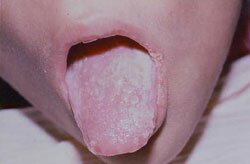|
January 2001
Answer: Oral candidiasis and herpes simplex

Oral candidiasis and herpes simplex |
On physical examination Maria is found to have a white pseudomembranous coating on her tongue, and angular cheilitis. These findings are consistent with oral candidiasis. Underlying the white plaques are vesicular lesions consistent with herpes simplex.
The clinical manifestations of oral candidasis in children with HIV are variable. Oral examination may reveal white-tan pseudomembranous plaques on the tongue, buccal mucosa, gingival tissue, palate, and/or posterior oropharynx. These plaques may become confluent and extend down the throat into the esophagus. If an attempt is made to remove these lesions, the underlying mucosa will bleed. Angular cheilitis, a white-coated lesion at the corner of the mouth, may be apparent. However, in some cases the only finding may be a limited or diffuse area of mucosal erythema. Definitive diagnosis of candida infection is made by microscopic examination of a scraping of the lesion suspended in 10% potassium hydroxide, or by a gram stain that reveals yeast or pseudohyphae.
Oral candidiasis can be treated with medications that are given by mouth. Nystatin suspension (100,000 units/ml) can be given to infants in a dose of 200,000 units 4 times a day for 2 weeks; or to children and adults in a dose of 400,000 to 600,000 units 4 times a day for 2 weeks. Alternatively, fluconazole can be given to infants and children in one dose of 6mg/kg on day one, and then a daily dose of 3mg/kg daily for a total of 14 days; or to older children and adults as 200 mg on day one, and then 100 mg daily for a total of 14 days. Children who have had repeated episodes of oral candidiasis can be treated prophylactically with nystatin suspension at treatment doses, or with fluconazole 100 mg, once weekly.
Herpes simplex virus causes recurrent oral lesions in children with HIV infection. The child can develop painful vesicles or ulcers on the tongue or other mucosal surfaces. The lesions may be obscured by other oral disorders, such as candida. Herpes simplex can be diagnosed by obtaining a viral culture or direct immunofluorescent assay (DFA) of the lesion. Specimen collection methods most likely to yield positive results include swabbing the base of an intact vesicle, or the edge of an ulcerated lesion.
For children who have adequate oral intake, herpes simplex can be treated with acylovir 10mg/kg 5 times a day for 5-7 days. If the child is not taking fluids well intravenous acyclovir (10mg/kg every 8 hours) will be necessary.
HIV-infected children are predisposed to developing fungal and herpes simplex infections due to defective cell-mediated immunity. Oral lesions caused by candida or herpes simplex can be very painful and cause significant morbidity. It is not uncommon for children with HIV infection to have simultaneous infection of the oral cavity with more than one pathogen. Therefore it is imperative to perform a meticulous oral examination on every child with HIV infection.
|